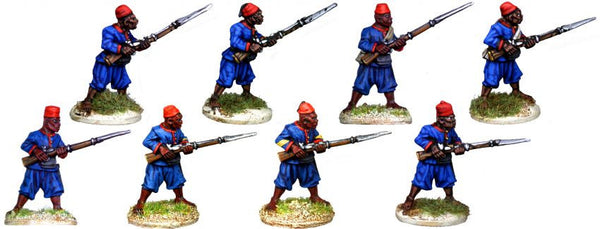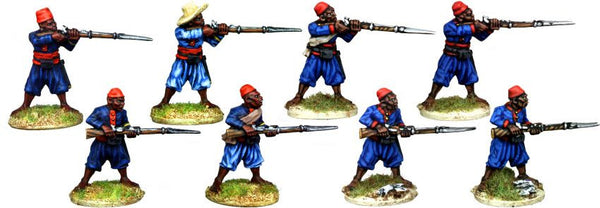Darkest Africa: Belgians
Desperate for a colony to enhance his prestige King Leopold II of Belgium, in his role as a dodgy businessman managed to create a personal fiefdom, The Congo Free State, in the very heart of African darkness. To protect and expand his property Leopold also set up a private army, the Force Publique. Before long, using forced labour and gruesome punishments in its search for quick profits from ivory and rubber, The Congo Free State descended into horror (observed by Joseph Conrad, amongst others), until public opinion forced the Belgian state to take over. Meanwhile the Force Publique and its tribal allies, notably Gongo Lutete's Tetela, smashed the developing Arab states of the Congo in a series of hard campaigns in the early 1890s, fought and defeated the Mahdists at the battles of Bedden and Redjaf and clashed with many understandably hostile tribes, especially the Azande. The brutal treatment of the men by their officers led to a number of major mutinies, in which the mutineers often kept their uniforms and military organisation. It's cannibal recruits gave the Force Publique a fearsome reputation, as well as an efficient way of dealing with the dead after battle.
Actually, all of our colonial europeans ( even the dastardly Belgiums ) will serve perfectly well as european or american adventurers, adventuresses and officers boldly going forth in anywhere hot in the world! Any Askari models could also serve any of the colonial nations.
We have a large number of customers fighting battles and skirmishes in historical, Victorian adventure, Steampunk or roleplay settings. using our Victorian Adventurers from the Darkest Africa range alongside the many hundreds of miniatures from our various African, Asian, Oriental and Victorian Historical ranges ( lots of appropriate models in the Old West ranges too ).
OFFICERS
Mostly Belgian, although some Scandinavians and Scots, with the occasional rennagade Italian/Englishman etc.
Hats - white tropical helmet with yellow metal badge, navy blue peaked cap (black peak) with rank insignia in bands around body of cap, red fez or broad-brimmed hat of civilian type.
Jacket - dark blue or white with yellow metal buttons. Gold rank insignia on both sleeves - on the white coat these were on blue patches. Small yellow lion above rank insignia on right sleeve only. Small yellow metal badge (star and crown) on ends of collar.
Frockcoat - very dark blue with brass buttons and standard rank markings.
Rank Markings (a selection)
Commandant - 1 wide band and 4 narrow gold bands
Captain - 1 wide band and 2 narrow gold bands
Lieutenant - 1 wide band and 1 narrow gold band
Sub-Lieutenant - 3 narrow gold bands
Trousers - dark blue or white to match jacket BUT white trousers were often worn with dark blue jacket but not the other way round.
Shoes - black or white (with white trousers only)
Boots and Belts - black
NCOs
White helmet, white trousers with dark blue or white jacket. Possibly one or two narrow gold bands on both sleeves.
ASKARIS
Blouse - dark blue with red piping around neck , down front 3-button opening and around end of sleeves
Trousers - dark blue
Headgear - usually a red fez , although large straw hats were often worn in drier parts of the Congo (sometimes over the fez).
Sash - red (if worn).
Belt and Pouch - black
Rank Markings - worn on lower sleeves at an angle:
Sergeant Major - 3 stripes in gold and red mixture
Sergeant - 2 stripes in gold and red mixture
Corporal - 3 yellow stripes
Private 1st Class - 2 yellow stripes (on left sleeve only)
Private 2nd Class - 1 yellow stripe (on left sleeve only)
Flags - each company carried a 80cm x 80cm colour - the yellow 5 pointed star on a light blue background of the Congo Free State.







